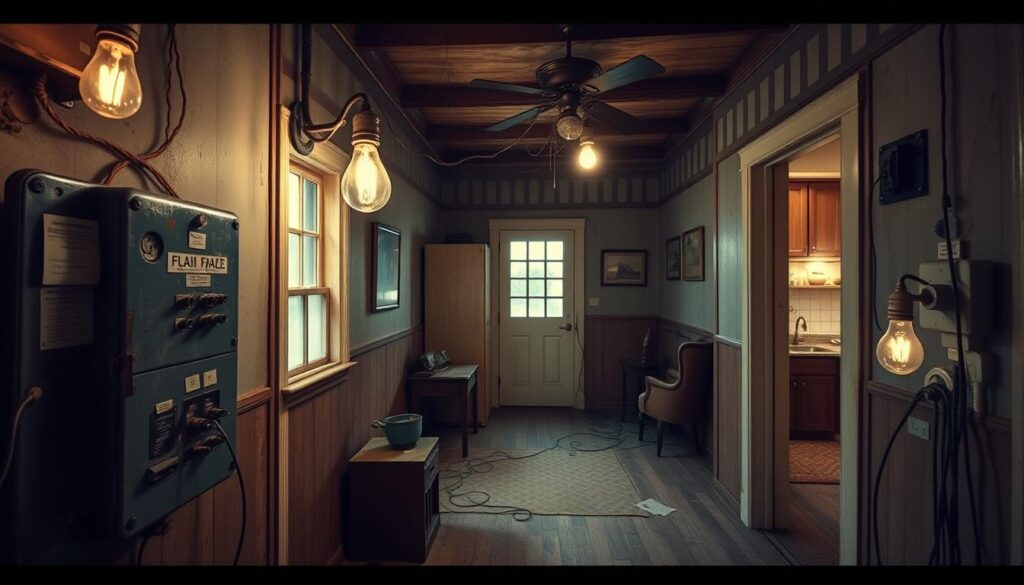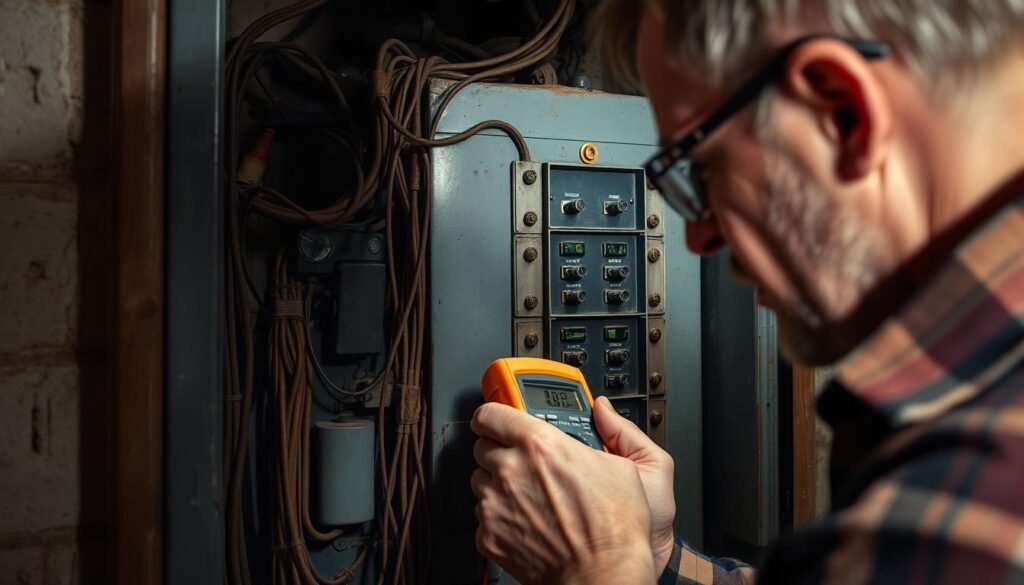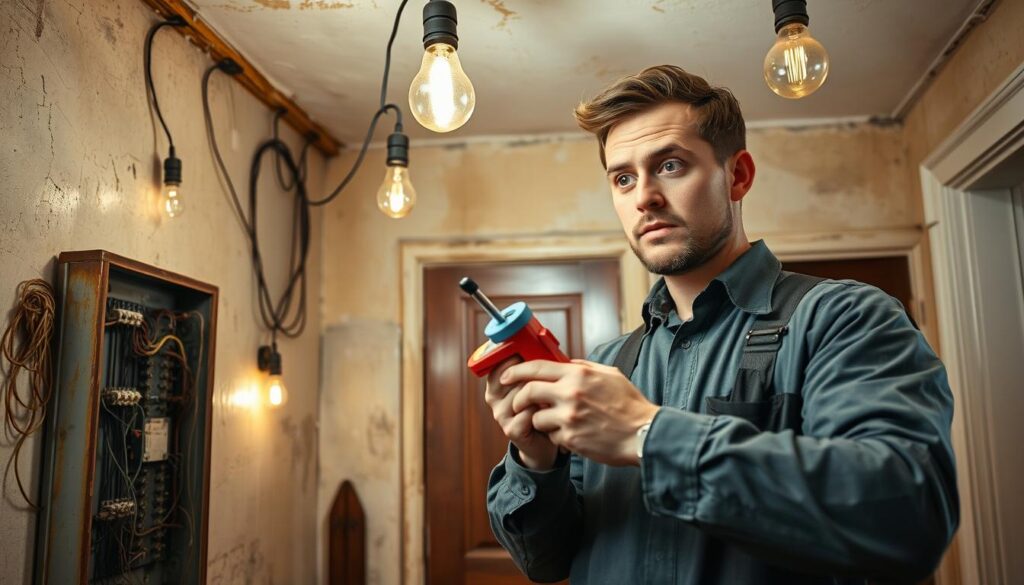Living in a vintage or historic home is a joy, but it comes with its own set of challenges. These homes, built long ago, can’t handle today’s electrical needs. Issues like outdated wiring and old breaker panels can be serious safety risks and affect your home’s power.
In this guide, we’ll look at the common electrical problems in old homes. We’ll also share practical ways to fix them. This article is for homeowners, real estate investors, and anyone interested in old-house living. It will help you understand and solve the electrical issues that come with owning a classic home.
Understanding Electrical Systems in Vintage Houses
Looking into the history of wiring in old houses can teach us a lot. It shows how unique electrical systems in vintage homes were. Knowing about the past helps homeowners deal with the upkeep and updates of their historic homes.
Evolution of Residential Wiring Standards
Electrical systems in old houses have changed a lot over time. As safety rules got stricter, wiring materials and methods changed too. Learning about these changes helps us understand the history of home electrical systems and the special needs of older homes.
Key Components of Old Home Electrical Systems
Old electrical systems had special parts made for their time. Knowing about these parts, like knob and tube wiring, helps homeowners find and fix electrical problems in their homes.
Common Wiring Types in Historic Properties
Old homes have many types of wiring, each with its own features. From early 20th-century cloth-covered cables to modern Romex wiring, knowing these types helps spot and fix electrical issues.
By exploring wiring standards, key components, and common wiring types in old homes, homeowners learn about the unique challenges of their vintage homes. This knowledge helps them maintain their homes’ electrical systems better.
Signs Your Old Home Has Outdated Electrical Wiring
If you own a vintage home, it’s important to know the signs of outdated wiring. Spotting these outdated wiring symptoms early can prevent bigger issues. Here are some key old electrical system indicators to look out for in your vintage home wiring:
- Frequent circuit breaker trips or blown fuses
- Flickering or dimming lights
- Warm or discolored electrical outlets and switches
- Buzzing or crackling sounds from outlets or wiring
- Sparks or arcing when plugging in devices
These vintage home wiring red flags could mean your electrical system is overloaded or old. Not fixing these signs can lead to fires, electrical shocks, or other dangers. Getting a qualified electrician to check your wiring regularly is key to avoiding these risks.
“Addressing electrical issues in an older home should be a top priority for any homeowner. Ignoring these old electrical system indicators can put your family’s safety at risk.”
Knob and Tube Wiring: Risks and Solutions
Many older homes have a special electrical system called knob and tube wiring. This system is charming but also very dangerous. Homeowners need to take action to stay safe.
Identifying Knob and Tube Installations
Knob and tube wiring is easy to spot. It has exposed wires in porcelain tubes and “knobs” that hold the wiring in place. This old system was used before the 1950s. It’s found in walls, ceilings, and crawl spaces. Knowing you have knob and tube wiring is the first step to fixing safety issues.
Safety Concerns with Original Wiring
Knob and tube wiring is risky for several reasons:
- Fire Hazards: Its exposed design can get damaged easily, leading to short circuits and fires.
- Electrical Shocks: Without a grounding system, it can cause shocks and electrocution.
- Outdated Capacity: It may not handle today’s electrical needs, causing overloaded circuits.
Replacement Options and Costs
Updating an old electrical system is key for safety and function. Homeowners have a few choices:
- Complete Rewiring: This is the most expensive but safest option, replacing everything with new wiring.
- Partial Rewiring: This is cheaper, focusing on the worst areas of knob and tube wiring.
- Upgrading with Parallel Wiring: New wiring can be added alongside the old, offering a modern system without removing the original.
The cost of these updates varies a lot. It depends on the home’s size and complexity. Costs can range from $3,000 to $15,000 or more.
Fixing knob and tube wiring is vital for keeping historic homes safe and intact. By knowing the risks and the options, homeowners can update their electrical systems. This way, they can keep their homes safe while preserving their historical charm.
Electrical Problems in Older Homes and Their Warning Signs
Older homes can have serious electrical risks. Issues like outdated wiring and faulty parts are common. Knowing the warning signs helps homeowners stay safe.
Knob and tube wiring is a big problem in old homes. It’s outdated and can cause fires. Look for exposed wires and old electrical boxes to spot it.
Aluminum conductors are another issue. They can lead to fires. Watch for discolored outlets and flickering lights as signs.
- Flickering or dimming lights
- Warm or discolored outlets and switches
- Frequent circuit breaker tripping
- Buzzing or crackling noises from electrical panels
- Scorch marks or burn spots on outlets or wiring
Fixing these problems quickly is key. Recognizing signs and getting help ensures safety. This keeps your home safe from fires and shocks.

| Warning Sign | Potential Issue |
|---|---|
| Flickering or dimming lights | Loose connections, voltage fluctuations |
| Warm or discolored outlets and switches | Overloaded circuits, faulty wiring |
| Frequent circuit breaker tripping | Overloaded circuits, short circuits |
| Buzzing or crackling noises from electrical panels | Outdated or malfunctioning electrical panel |
| Scorch marks or burn spots on outlets or wiring | Electrical fire hazard, overheating issues |
Outdated Electrical Panels and Circuit Breakers
Older homes often struggle with their electrical systems. One big problem is outdated electrical panels and circuit breakers. These parts are key to managing electricity safely in your home. But, they can become outdated and less efficient over time.
Common Panel Issues
Electrical panels in older homes may struggle with today’s power needs. This can cause tripped breakers, flickering lights, and even fires. Older panels also might not follow today’s safety standards, risking your home and family.
When to Upgrade Your Panel
If your home was built before the 1970s, your electrical panel likely needs an update. Look out for signs like frequent breaker trips, burning smells, or the need to add new circuits. These are clear signs it’s time for a fuse box replacement or circuit breaker upgrades.
Modern Safety Requirements
Upgrading your electrical panel modernization boosts your system’s efficiency and safety. Modern panels have breakers that quickly cut off power in case of a fault. This reduces the risk of fires and electrical shocks.
By fixing outdated electrical panels and circuit breakers, you make your home safer and more functional. This ensures your electrical system can meet today’s needs.
Insufficient Outlets and Overloaded Circuits
Older homes often have too few outlets. This makes it hard to fit all our modern appliances and gadgets. People use extension cords and power strips, which can cause fires.
To fix this, we need outlet shortage solutions and circuit overload prevention. Upgrading your home’s electrical system is key to safety and function.
Increasing Electrical Capacity
Adding more outlets and upgrading the electrical panel can help. This means:
- Installing new outlets in key spots around the house
- Changing the electrical panel to handle more power
- Swapping old wiring for new, efficient cabling
These steps make your home safer and more convenient. They also get it ready for future electrical needs.
| Electrical Upgrade | Benefits | Estimated Cost |
|---|---|---|
| Adding New Outlets | More convenience, less fire risk | $75 – $150 per outlet |
| Upgrading Electrical Panel | More power, safer, future-proof | $1,000 – $3,000 |
| Rewiring Home | Safe, efficient electrical system | $5,000 – $15,000 |
Fixing outlet shortage solutions and circuit overload prevention in older homes is crucial. It keeps your electrical system safe and working well for years. Investing in these upgrades gives you peace of mind and protects your home from electrical dangers.
Ground Fault Issues in Historic Properties
Older homes often face unique electrical challenges. These include grounding and ground fault protection. It’s key to understand these issues to keep your vintage property safe.
Understanding Grounding Problems
Many historic homes lack modern grounding standards. This can lead to ungrounded outlets, a big safety risk. Especially in wet areas like bathrooms and kitchens.
Lack of grounding can cause electric shocks, fires, and other dangers. It’s important to address these issues.
Solutions for Ungrounded Outlets
- Replacing ungrounded outlets with GFCI (ground fault circuit interrupter) outlets is a reliable solution to improve electrical safety in wet areas.
- GFCI outlets can detect ground faults and quickly cut off power. This minimizes the risk of electric shocks and fires.
- Upgrading to GFCI outlets is especially important in bathrooms and kitchens. Here, GFCI installation is often required by modern electrical codes.
Safety Upgrades for Bathrooms and Kitchens
There are other important safety upgrades for older homes with ungrounded outlet solutions. These include:
- Installing GFCI circuit breakers to protect entire circuits in high-risk areas
- Adding surge protectors to safeguard against power surges and electrical spikes
- Considering the installation of an arc fault circuit interrupter (AFCI) to prevent electrical fires
By addressing ground fault issues and upgrading electrical safety in wet areas, you can ensure the well-being of your family. And protect the integrity of your historic home.
DIY Electrical Inspections vs. Professional Assessment
When it comes to keeping your older home’s electrical systems in check, you have two choices. You can do a DIY home electrical inspection or hire a professional electrician. While DIY might save you money, it’s important to think about safety.
A home electrical inspection done by you can be a good start. It helps spot issues like exposed wiring and outdated outlets. But, a detailed professional electrician services check is key for a full review and finding hidden safety problems.
- DIY safety checks can spot some problems, but might miss others
- Professional inspections give a full look at the home’s electrical system
- Skilled electricians can find and fix complex issues, like old wiring or overloaded circuits
In the end, while DIY checks are useful, a pro’s assessment is best for safety and reliability. A detailed check by a licensed electrician is worth it. It can prevent expensive and dangerous problems later on.
| DIY Electrical Inspection | Professional Electrical Assessment |
|---|---|
|
|

“Proper electrical maintenance is essential for the safety and longevity of an older home’s electrical system.”
Modern Solutions for Classic Home Electrical Systems
Homeowners want to keep their old homes looking great. Adding smart home upgrades for old houses can be tricky. But, it’s doable to mix new tech with the old charm.
Smart Technology Integration
Today’s smart home tech can make old homes better. You can get smart lights and plugs that save energy. This way, you keep your home’s old feel while using new tech.
Energy-Efficient Upgrades
Switching to energy-efficient electrical systems is smart. It cuts down on energy use and bills. You can get new appliances, LED lights, and smart thermostats to save energy.
Preserving Historical Character
When updating old homes, keep the old charm. Work with skilled electricians and preservation experts. This way, you can add new systems without losing your home’s unique look.
“Integrating smart technology and energy-efficient upgrades in older homes requires a delicate balance, but the results can be truly transformative. With the right approach, homeowners can enjoy the benefits of modern conveniences while preserving the historic character of their beloved properties.”
Conclusion
Electrical issues in old homes are serious. Problems like outdated wiring and unsafe panels can be dangerous. But, with the right help, these issues can be fixed without losing the home’s charm.
Knowing about old wiring and electrical systems helps homeowners spot problems early. They can then upgrade their homes safely. Replacing old wiring and modernizing panels are key steps to safety and value.
When dealing with old home electrical work, getting help from experts is key. Licensed electricians know how to update old homes without losing their unique look. By focusing on vintage home electrical safety, old house wiring maintenance, and historic property electrical upgrades, homes can stay safe and beautiful for years.
FAQ
What are some common electrical problems in older homes?
Older homes often face issues like outdated wiring, not enough outlets, and circuits that are too full. They might also have ground fault problems and old electrical panels or circuit breakers.
How can I identify if my home has outdated electrical wiring?
Look for flickering lights, circuit breakers that keep tripping, and warm outlets or switch plates. Cloth-covered or ungrounded wiring is also a sign. Getting a professional to check your wiring can help spot problems.
What are the risks associated with knob and tube wiring?
Knob and tube wiring is common in old homes but is risky. It can cause fires and doesn’t work well with today’s devices. It’s often needed to be replaced for safety and efficiency.
How can I address insufficient outlets and overloaded circuits in my older home?
Adding more outlets and upgrading your electrical panel or circuit breakers can help. Make sure to hire a licensed electrician to do this safely and correctly.
What are the benefits of a professional electrical inspection for my vintage home?
A professional inspection can find hidden problems and check your system’s condition. They can also suggest upgrades or repairs. This keeps your home safe, efficient, and valuable.
What modern solutions are available for upgrading electrical systems in older homes?
You can add smart home tech, make energy upgrades, and design smartly to update your home. Working with experts ensures these changes are done right and keep your home’s history intact.


